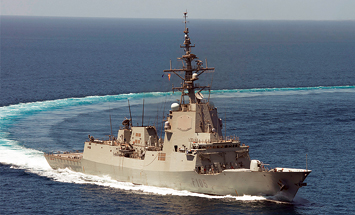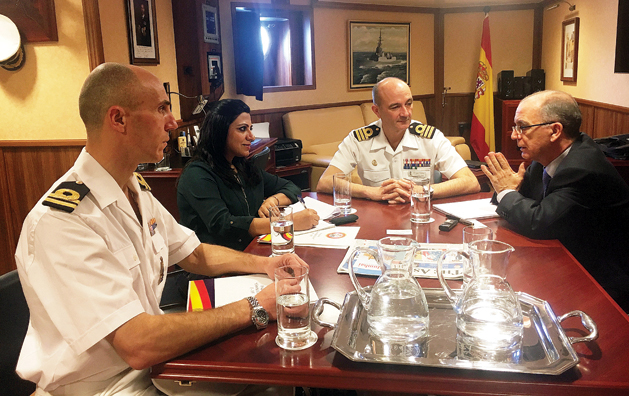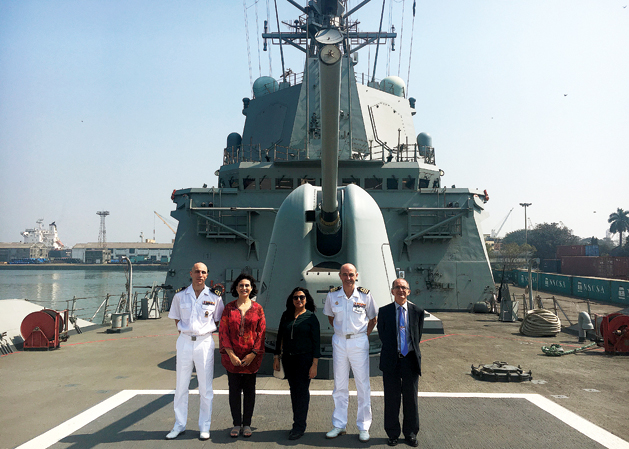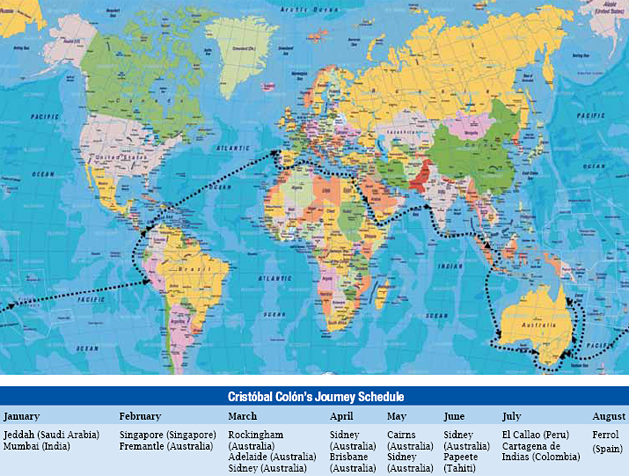INDIAN ARMED FORCES CHIEFS ON
OUR RELENTLESS AND FOCUSED PUBLISHING EFFORTS

SP Guide Publications puts forth a well compiled articulation of issues, pursuits and accomplishments of the Indian Army, over the years

I am confident that SP Guide Publications would continue to inform, inspire and influence.

My compliments to SP Guide Publications for informative and credible reportage on contemporary aerospace issues over the past six decades.
Exclusive
Navantia is Here (in India) to Remain
Neetu Dhulia of SP’s Naval Forces had an exclusive opportunity to visit the Frigate F-105 – Cristóbal Colón, visiting Mumbai and to interact with the Commander Ignacio Cuartero Lorenzo, Commanding Officer, and his team along with Navantia’s Alberto Gorordo, General Manager India, and Carmen Gonzalez Martin
buy amoxicillin without prescription
amoxicillin prescription no insurance
TECHNICAL CHARACTERISTICS
Displacement
6,391 tonnes / Length: 146.7 m / Beam: 18.6 m / Depth: 8 m / Max speed: 29 knots / Range: 4.800 miles / Crew: 201 (plus 36 Air Crew and Staff).
Propulsion
The propulsión system in the ship is a CODOG system (Combined Diesel or Gas), with the following elements:
- 2 gas turbine GE LM2500.
- 2 Bazan Bravo-16 diesel motors, Navantia/Caterpillar.
- 2 propellers.
- 2 shafts.
- 1 bow thruster.
The electrical plant has four diesel generators of 1,100 kW. The ship has also an Integrated System of Platform Control developed and built by Navantia which allows to have a better operative employment of the ship.
Combat System
The ship is fitted with the Aegis Combat System with Spanish-made Systems integrated.
Missiles
- VLS Mk-41 Mod.24 designed to launch SM-2 and ESM.
- 2 HARPOON Canister Missile Launchers up to 8 missiles.
Guns
- 5"/54 Mk-45 Mod.2.
- 2 BAE 1 Small Caliber Gun Mk 38 Mod.2.
Torpedoes
- 2 Mk 32 Mod 9 Torpedo Tubes for Mk-46 Mod 5 Torpedoes.
Radars
- Multifunction Radar SPY-1D (V).
- ARIES SAS Radar.
Sonar
- LWHP53SN Hull Mounted Sonar.
Communications
- SECOMSAT & INMARSAT satellite.
- Link 11 & 16.
- GMDS.
Helicopter
- Capability of one SH60-B Seahawk on board.
It was a perfect January morning with the sun shining brightly on the Mumbai port and basking in all its glory was the majestic Cristóbal Colón adorning the Ballard Pier.
Coming from the house of Navantia Shipyard in Ferrol, frigate F-105 – Cristóbal Colón was commissioned into Spanish Navy on October 23, 2012, within an enviable short span of two years. The frigate F-105 Cristóbal Colón is the fifth ship of the new class F-l00, with modern design and outstanding military capabilities.
She is named after the discoverer of the ‘New World’, famous Admiral of Spanish Navy. Cristóbal Colón was in Mumbai on its onwards journey from Ferrol, Spain, circumnavigating the world for seven months. The frigate left her base in Ferrol on January 9, 2017, in order to take part in a deployment with the Royal Australian Navy (RAN). Under an agreement between the two navies, the Aegis-equipped frigate will spend 120 days in Australia where it will help train future Australian Hobart class destroyer sailors of the Australian Navy. By integrating into the Australian Navy fleet, Cristóbal Colón will provide dedicated training and familiarisation opportunities for the crews of Australian destroyers Hobart, Brisbane and Sydney. Cristóbal Colon will be returning to home port on August 4, 2017.
An interaction with the Commanding officer:
Neetu Dhulia (Dhulia): Frigate F-105 is configured for multi-mission roles. Has the ship successfully achieved designed parameters?
Ignacio Cuartero Lorenzo (Commander): The Frigate F-105 is a multi-purpose ship with the great capabilities. It is a mediumsize oceanic escort. Command and control of the ship is exceptional in conflict scenarios. The frigate is capable of operating with allied fleets, and providing cover when required to expeditionary forces.
Cristóbal Colón is capable of operating in coastal and blue waters depending on the conflict situation. It boasts of a high anti-air capability.
The Aegis Combat System, with its SPY-1D radar, permits threat detection in difficult environmental conditions, those are characteristic of coastal waters, providing the necessary firepower to counteract them. The ship design reduces her electromagnetic, infrared and acoustic signatures.
The ship also has an embarked helicopter (LAMPS Mk-III) with modern sensors and weapons that can detect and attack surface and submarine ships when the ship’s weapons are out of reach.
Dhulia: Cristóbal Colón is headed to Australia post her maiden visit to India. Please share details on her deployment to Australia.
Commander: F-105 will spend four months in Australia from Febraury to June 2017. The Cristóbal Colón deployment to Australia will provide both the Royal Australian Navy (RAN) and Armada with unique training and capability assessment opportunities. Aims of the Cristóbal Colón deployment are to enhance interoperability between the Armada and RAN providing collective training opportunities for selected RAN personnel that will serve in the Hobart Class DDG.
This deployment will provide collective training opportunities for both participants, through interaction between Cristóbal Colón and RAN Ships and helicopters, as well as by jointly taking part in national and international exercises where mutually determined.
This mission enables Armada to evaluate Cristóbal Colón’s range of capabilities, including logistic and maintenance support mechanisms for the ship during an extended period of high operational tempo deployed at an extended range from Spain. Last but not the least, it augments developing strategic partnership between the RAN and Spanish Armada.
Dhulia: Please throw some light on relationship between Spanish Navy and Navantia.
Commander: Regarding the shipbuilding, this ship is final product of partnership between the Spanish Navy and the company — Navantia and it isn’t just the product, resultant from a couple of years’ hard work. We date back three centuries together. There is an experience of 300 years between us and we have managed to combine our experience in defining concepts for new ships and Navantia’s experience in building ships, for example, they now build ships in parts where everything is put inside each block before putting all together. Once they put all the blocks together the ship is almost ready and we only have to put people inside and some spare parts, some liquids and the ship starts running.
Cristóbal Colón is capable of operating in coastal and blue waters depending on the conflict situation. It boasts of a high anti-air capability.
This is the success of Navantia in building ships and is the success of Armada in working with them. Navantia is thorough in their concepts, the shipyard is always interacting with us and they produce what we need.
Dhulia: F-105 Frigate Cristóbal Colón was commissioned into Spanish Navy in a short span of two years. How this was made possible?
Commander: There is a permanent interaction with the shipyard — Navantia and us and in fact we were born together more than 200 years ago and in our history we have been getting apart and coming together again, we have always progressed in the same direction. The way Navantia constructs ships is very different and progressive. The process for the building and commissioning the ship is very short. Traditionally the time frame needed to have a ship at sea is between 10 and 15 years, and the strategic situation changes in 15 years, so the shorter you make it, the better you are. F-105 Frigate Cristóbal Colón was launched in 2010 was commissioned in 2012 and early in 2014 was deployed for the first time to the Indian Ocean to take part in the counter-piracy operation ‘Ocean Shield’ and the counter-terrorist operation ‘Active Endeavour’ in the Mediterranean Sea.


Dhulia: What are the special characteristics of F-105 Frigate Cristóbal Colón?
Commander: She has excellent skills to be safely deployed in all kinds of situations. The frigate is a very valuable tool at the service of the Spanish Government foreign policy, not only taking part in conventional operations, but also in peacekeeping and humanitarian missions, imposition of UN resolutions, etc. She has state-of-the-art systems which are highly interoperable. Advanced technology reduces the requirement of manpower; this ship runs with a very professional crew of 180 people, whereas similar size ships require around 400 people. Cristóbal Colón ranks amongst the top warships and is able to perform any antiwarfare role. Mr. Gorordo and Ms. Martin from Navantia can elaborate more.
A. Gorordo: The methodology we are following for long time is to work closely together with the Navy. We nominate experts from Navantia to work with the Navy, we go through the feasibility studies, and they are in sync with the Commander’s and navy’s requirements. Of course, very rightly put by the Commander that we are living together since centuries. Navantia today is on the duty of navies of the world. A very good example is what we are doing in India now is more or less the same what we did in Australia in the beginning. The scope has widened, Navantia is working on partnership basis with Larsen & Toubro (L&T) for the Landing Platform Docks (LPD), an important program with your Navy here. We are starting in a low profile role with this and we don’t pretend to be biggest from the onset. The arrangements between us is that we will be supporting L&T in this programme as and when it is awarded to L&T. In the context of ‘Make in India’, our experience in Spain was more or less similar. We started in the 1970s and this process took 30 to 40 years. When we went ahead we were supported by the United States and then in the 1990s we were able to go ahead ourselves. There is no way you can reach to final point from scratch, on your own, it is a progressive and collaborative work.
C.G. Martin: I only want to add that we are very proud of the F-105. The Commander spoke about the Aegis Combat System, this is part of Navantia in fact, many of the systems onboard are Spanish and from the house of Navantia. Navantia Sistemas is in charge of this integration and working on systems. Also, that the market is asking for transfer of technology (ToT) and Navantia has long experience in ToTs in case of LPD. We have built two LSDs (Landing Ship Docks) for the Navy with special model of agreement of ToT and now we are also building one LSD, LPD in Turkey and this is being built in the Turkish shipyard. I only want to add that we are very proud of the F-105. The Commander spoke about the Aegis Combat System, this is part of Navantia in fact, many of the systems onboard are Spanish and from the house of Navantia. Navantia Sistemas is in charge of this integration and working on systems. Also, that the market is asking for transfer of technology (ToT) and Navantia has long experience in ToTs in case of LPD. We have built two LSDs (Landing Ship Docks) for the Navy with special model of agreement of ToT and now we are also building one LSD, LPD in Turkey and this is being built in the Turkish shipyard.

ABOUT NAVANTIA
Navantia, the Spanish shipbuilder is 100 per cent owned by the Spanish Government, is a world reference in the design, construction and integration of state-of-the-art warships, as well as civil ships, offshore structures, ship repairs and modernisations. It is also engaged in the design and manufacture of integrated platform management systems, fire control systems, command and control systems, propulsion plants and through life support for all its products. Even though its main line of activity is in the naval field, Navantia designs and manufactures systems for the Army.
Navantia is a reference in surface warships, having been able to integrate the Aegis LM system in a much smaller platform.
It has designed and built the F-100 Alvaro de Bazán class frigates (5 units) for the Spanish Navy and the F-310 Fridtjof Nansen class (5 units) in service at the Royal Norwegian Navy. The Australian Warfare Destroyer, currently under construction, is another Navantia design also based in Navantia F-100 Frigate.
Navantia develops its own systems and is capable of delivering products integrating complex systems, including ones made by other suppliers. It is also a leading company in the development, fabrication and maintenance of diesel engines, gearboxes, shaft lines, and steam turbines.
The principal advantage of Navantia, achieved in many years of experience and clients, is the flexibility to adapt to different requirements of the client, as well as the capability to offer global solutions throughout the entire life-cycle of all of its products: ships, systems, propulsion and energy. Providing engineering capability, transfer of technology and technical assistance to its clients in every part of the world.





